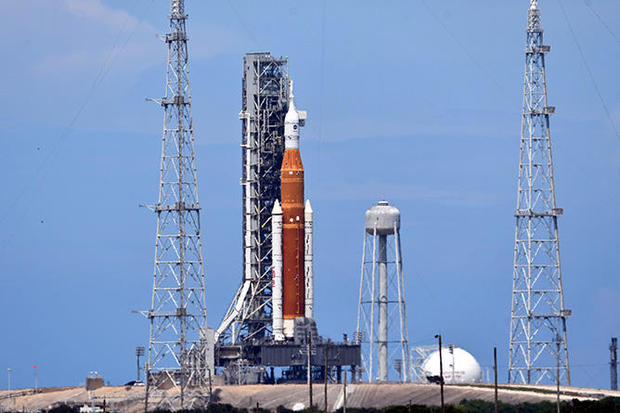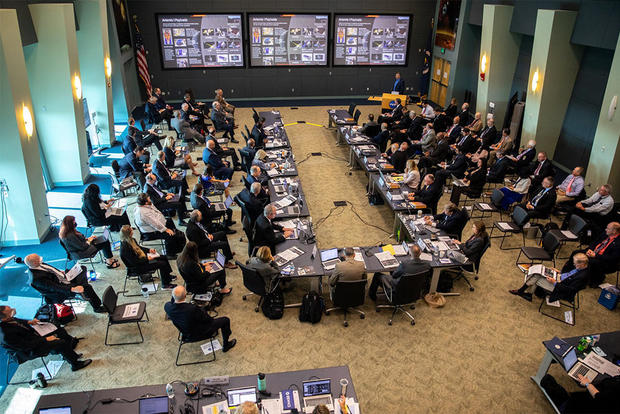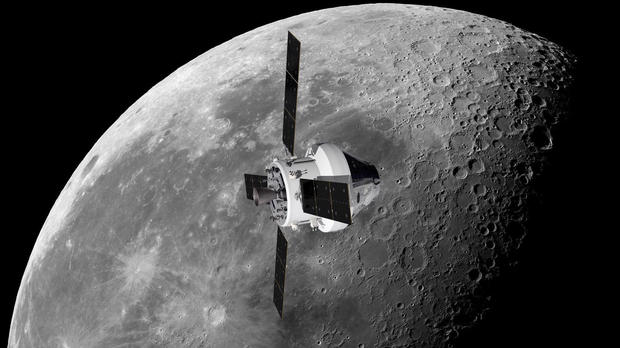With one week to go until launch, NASA managers met at the Kennedy Space Center, reviewed flight preparations and cleared the agency’s huge $4.1 billion Space Launch System rocket for blastoff next Monday on a test flight heralding an American-led return to the moon.
After an all-day meeting to go over technical details, open issues, the weather and a variety of other factors, the launch team was cleared to press ahead toward the start of a 46-hour 10-minute countdown beginning at 10:23 a.m. ET Saturday, setting the stage for blastoff at 8:33 a.m. Monday at the opening of a two-hour window.
If all goes well, the 322-foot-tall SLS rocket, the most powerful ever built by NASA, will boost an unpiloted Lockheed Martin-built Orion crew capsule and its European Space Agency-supplied service module on a 42-day flight that will carry the spacecraft 40,000 miles beyond the moon and back to Earth for a Pacific Ocean splashdown on Oct. 10.
William Harwood/CBS News
“We are go for launch, which is absolutely outstanding,” Bob Cabana, a former shuttle commander and now an associate administrator, told reporters after the flight readiness review. “This day has been a long time coming.”
But he quickly added, “this is a test flight. It’s not without risk. We have analyzed the risk as best we can and we’ve mitigated it also as best we can. But we are stressing Orion beyond what it was actually designed for in preparation for sending it to the moon with a crew.”
“And we want to make sure it works absolutely perfectly when we do that and that we understand all the risks,” he said. “We’re going to learn a lot from this test flight.”
Generating 8.8 million pounds of thrust from two extended solid-fuel boosters and four upgraded space shuttle main engines, the 5.5-million-pound SLS rocket is expected to hit 100 mph — straight up — in about seven seconds, putting on a ground-shaking spectacle for thousands of spaceport workers, area residents and tourists.
The Boeing-built core stage, Northrop Grumman strap-on boosters and an upper stage provided by United Launch Alliance will boost the Orion crew capsule into a long orbit around the moon for a complex series of tests and checkout before it returns to Earth.
NASA
The top priority of the Artemis 1 mission is to test the Orion capsule’s 16.5-foot-wide heat shield and its ability to protect the craft when it slams into the atmosphere at some 25,000 mph, enduring temperatures up to 5,000 degrees before a parachute descent to splashdown west of San Diego.
Successfully launching the SLS is built into that top priority because it’s the rocket that will provide the energy to boost the Orion capsule beyond the moon, setting up that fiery, high-speed re-entry.
Years behind schedule and billions over budget, the rocket’s maiden launch is a long-awaited milestone. If the flight goes well, NASA will press ahead with plans to launch four astronauts around the moon in an Orion capsule in late 2024 before attempting the Artemis program’s first piloted moon landing in the 2025-26 timeframe.
For the Artemis 1 mission, NASA will only have three near-term launch opportunities because of the constantly changing positions of Earth and moon, the requirements of Orion’s planned trajectory and the amount of propellant required to fuel the giant rocket.
European Space Agency
If the SLS can’t get off the ground next Monday, the launch team will only have two other opportunities, on Sept. 2 and 5, before the end of the current launch period and a trip back to the Vehicle Assembly Building for work to service self-destruct system batteries and other systems.
The next launch period opens on Sept. 19 and closes Oct. 4, but it’s doubtful the rocket could be returned to the pad in time for another countdown and launch attempt. More likely, NASA would be forced to aim for the launch period after that, which opens Oct. 17 and runs through Oct. 31.
Mission managers are hopeful it won’t come to that, and Launch Director Charlie Blackwell-Thompson, the first female to serve in that position, says she’s confident her team is up to the challenge, weather permitting.
“I think we have done all of the things that you can do to be ready,” she said in an interview with CBS News. “The flight hardware, it lets you know when it’s ready to fly. … I think it’s ready. But on launch day, I’ll know.”





